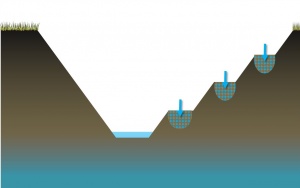Design infiltration rate
This article discusses the determination of a suitable infiltration rate to describe the native soils surrounding a proposed infiltration practice.
It does not relate to the hydraulic conductivity or permeability of filter media or planting media used within vegetated BMPs.
The design infiltration rate (f') is used in all sizing calculations for bioretention and bioswales, dry ponds, infiltration trenches and chambers, and exfiltration trenches. It is related to, but not always synonymous with 'permeability', 'field hydraulic conductivity' (Kfc), or 'saturated hydraulic conductivity' (Ksat). Before application a safety correction factor (SCF) is incorporated into the figure, depending upon the source of the raw data, and the risk of failure of the finished practice.
It is highly recommended that testing be conducted on site.
| On site testing methods | Off site analysis methods | Unacceptable methods |
|---|---|---|
|
|
Becoming familiar with the different measurement practices[edit]
STEP have produced a free online module to provide some basic information on infiltration test methods. Access it HERE
Safety correction[edit]
To apply conservatism, the measured or calculated infiltration rate may be divided by a value between 2 and 3 before use in design calcualtions[1]
| Lower value (closer to 2) | Higher value (closer to 3) |
|---|---|
| Catchment < 100 m² | Catchment > 100 m²[2] |
| Permeameter or percolation test on site | Double ring infiltrometer test on site, or grain size analysis used [3] |
| Loamy or sandy soil texture | Clayey soil texture[4] |
| No variation in geologic formation, soil texture or soil bulk density within 1.5 metres below the proposed bottom elevation of the practice. | Variation in geologic formation, soil texture or soil bulk density within 1.5 metres below the proposed bottom eleation of the practice observed. |
| No nearby sensitive receptors | Sensitive receptors in near proximity (e.g. septic systems, building foundations). |
Planning for testing[edit]
Background Evaluation[edit]
Prior to performing testing and developing a detailed site plan, existing site conditions should be inventoried and mapped including, but not limited to:
- Surficial geology and underlying stratigraphy;
- Watercourses (perennial and intermittent), waterbodies, wetlands and floodplains;
- Small headwater drainage features;
- Topography, slope, and drainage patterns;
- Existing land cover and land use;
- Natural heritage conservation areas; and
- Other man-made features or conditions that may impact design such as existing nearby structures (buildings, infrastructure, etc.).
A sketch plan or preliminary layout plan for the proposed development should be evaluated, including:
- The preliminary grading plan and areas of cut and fill;
- The location and water surface elevation of all existing, and location of proposed water supply sources and wells;
- The location of all existing and proposed on-site wastewater (septic) systems;
- The location of other features of note such as utility rights-of-way, water and sewer lines, etc.;
- Existing data from borehole, well and geophysical testing; and
- Proposed location of development features (buildings, roads, utilities, etc.).
Sampling[edit]
The number of test pits or soil borings varies depending on site conditions and the proposed development plan. General guidelines are as follows:
| BMP footprint (m²) | Test pit | Borehole |
|---|---|---|
| < 50 | 1 | 1 |
| 50 – 900 | 1 | 2 |
| 2 | 0 | |
| > 900 | 1 every 450 m² | 2 every 450 m² |
| 2 every 450 m² | 0 | |
| Linear | 1 every 450 m² | 1 every 50 m |
- Tests must be conducted within 10 metres of the infiltration practice footprint area.
- Tests should be performed within 48 hours of a rain event, when the soil is already near, or at field capacity.
- Test locations should be spaced equidistant from one another.
- Make a minimum of seven (7) measurements (i.e. tests) for each test location (i.e., each test pit or borehole).
- An additional round of tests should be conducted at 1.5 metres depth below the proposed bottom elevation of the practice if there is significant variation in geologic formation, soil texture or bulk density compared to conditions at the proposed bottom elevation.
- To calculate the median infiltration rate of the native soil at the depth tested, discard the highest and lowest values obtained from each test location and calculate the median from the remaining measurements.
The recommendations above are guidelines Keep in mind that excessive testing and disturbance of the site prior to construction is not recommended.[5]
- ↑ Design criteria for infiltration. (2018, February 14). Minnesota Stormwater Manual, . Retrieved 00:16, March 14, 2018 from https://stormwater.pca.state.mn.us/index.php?title=Design_criteria_for_infiltration&oldid=35583.
- ↑ Ballard, B. W., Wilson, S., Udale-Clarke, H., Illman, S., Scott, T., Ashley, R., & Kellagher, R. (2015). The SuDS Manual. London.
- ↑ San Francisco Public Utilities Commission. (2017). Determination of Design Infiltration Rates for the Sizing of Infiltration‐based Green Infrastructure Facilities. Retrieved from http://sfwater.org/modules/showdocument.aspx?documentid=9681
- ↑ CRC for Water Sensitive Cities. (2015). Adoption Guidelines for Stormwater Biofiltration Systems: Appendix C - Guidelines for filter media in stormwater biofiltration systems.
- ↑ Christopher B. Burke Engineering LLC. (2009). Soil Infiltration Testing Protocol SOIL INFILTRATION TESTING PROTOCOL Purpose of this Protocol Who Should Conduct Testing. Retrieved from https://www.in.gov/ocra/files/Appendix%20F%20-%20Soil%20Infiltration%20Testing%20Protocol.pdf
